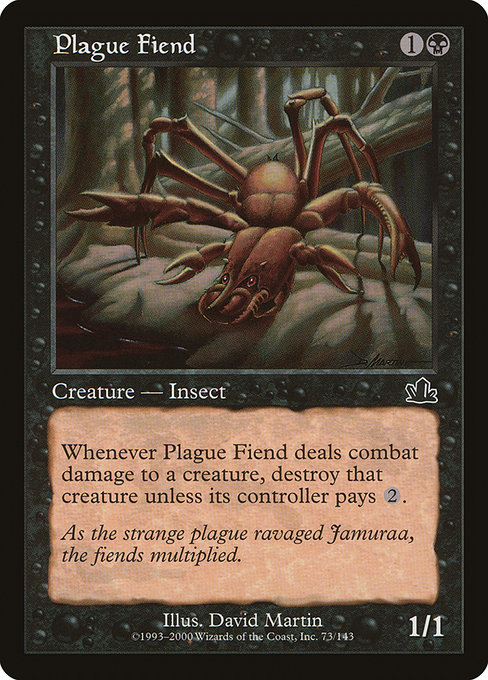
Image courtesy of Scryfall.com
Rewriting the Late-Game Board State with a Black Insect
In the sprawling dance of late-game MTG, every creature is a potential pivot point. Plague Fiend enters the fray as a deceptively simple 1/1 black creature for {1}{B}, but its true power lies in what happens after it connects in combat. The ability reads like a relentless bit of black mana tax: whenever this creature deals combat damage to a creature, destroy that creature unless its controller pays {2}. That narrow line of text carries big strategic clout once the game has grown teeth and fatigue has sharpened its edge. 🧙🔥💎
Think about the late-game board state: you might be staring down a flurry of blockers, value engines, and expensive threats that refuse to die. The Fiend’s trigger forces your opponent to weigh two kinds of resources at once—mana and opportunity. If they can’t or won’t pay the 2 mana to keep a creature alive, it’s gone, traded for your 1/1 with tempo on your side. If they do pay, they preserve the creature but expend mana that could otherwise fuel haymakers and stabilization plays. That tension is where late-game board states start bending toward attrition warfare, and Plague Fiend is happy to be the tax collector in the shadows. ⚔️
How the trigger reshapes combat calculations
In practical terms, the Fiend elevates every combat decision from a binary exchange into a negotiation with the board. Your opponent must consider: can I spare 2 mana to keep this blocker? If I don’t, I lose a creature and weaken my future blocks. With a steady influx of threats, you can leverage this tax to pry open lanes or force suboptimal blocks that reveal their win conditions earlier than they want. The late game becomes less about one big swing and more about a series of incremental squeezes, where each combat step erodes the opponent’s resources while you maintain a foothold. 🧙♂️🎲
- Incremental attrition — Each encounter with a 1/1 that requires a pay-2 tax compounds across turns. In long games, small decisions compound into big advantages.
- Blocking psychology — Opponents start treating their blockers as fungible assets rather than precious holds. The threat of destruction unless they pay changes how they allocate blockers and mana.
- Resource tax with minimal cost — The Fiend’s mana cost is tiny, but its debt is public. Your opponent must balance immediate board preservation against future plays in a way that benefits you as the attacker or as a stabilizer of a slower plan.
Flavor from the Prophecy era anchors this dynamic in Jamuraa’s plague-stricken setting. The flavor text—“As the strange plague ravaged Jamuraa, the fiends multiplied.”—echoes the idea that even small pests can surreptitiously overwhelm a battlefield if you don’t manage your resources. The art, by David Martin, underscores that granular, creeping threat—one that multiplies in impact as the game wears on. 🎨
“In the late game, the smallest bite can tip a tide. When your opponent must decide whether to pay to save a creature or let it go, that moment becomes the turning point.”
Practical deck-building angles for late-game resilience
Despite its size, Plague Fiend finds a comfortable seat in decks that lean into attrition, grindy value, or control-adjacent black themes. Here are a few ways players historically leveraged this creature in longer games, and how you might approach it today:
- Pair with generically powerful black removal — The Fiend doesn’t sneak through unblocked damage by itself; it’s better when your deck can clear blockers and give it a clean attack path. Think in terms of targeted removal or post-combat ways to pressure the board while your creature continues to tax opponents.
- Support with deathtouch or evasion if you lean midrange — An evasive or deathtouch creature can ensure the damage from Plague Fiend becomes a reliable trigger, increasing the likelihood of destroying opposing threats for a mana tax you can sustain over time.
- Stability through life- and resource-protection — In the late game, players often stabilize by gaining life or stalling on top-end threats. Fiend-style pressure fits well in decks that want to maintain a delicate balance between offense and defense, dragging the game toward a controlled finish.
- Value in Pauper and Vintage environments — The card’s common rarity made it a staple in certain Pauper archetypes, where cheap disruption and incremental advantage can win out against more expensive, flashy threats. In Legacy and Vintage, its ability to tax is less about raw power and more about shaping the battlefield’s tempo in tight exchanges. 🧙♀️
As you sketch your late-game plan, remember that Plague Fiend rewards patience and precise timing. It’s less about a single violent swing and more about delaying your opponent’s escalation long enough to slip in a final, decisive assault or to convert incremental damage into a board state they can’t recover from. The card’s cost efficiency and its tax-on-damage mechanic make it a quietly persistent threat and a memorable piece of Jamuraa’s plague-laden lore. ⚔️
For fans who enjoy weaving MTG craftsmanship with real-world gear, you can pair your nostalgia with a touch of style from a tech-forward shop—a reminder that good cards, like great accessories, deserve a solid home. If you’re repping your collector’s pride and want a sleek, high-detail accessory for your everyday gear, check out this phone case with glossy polycarbonate protection: